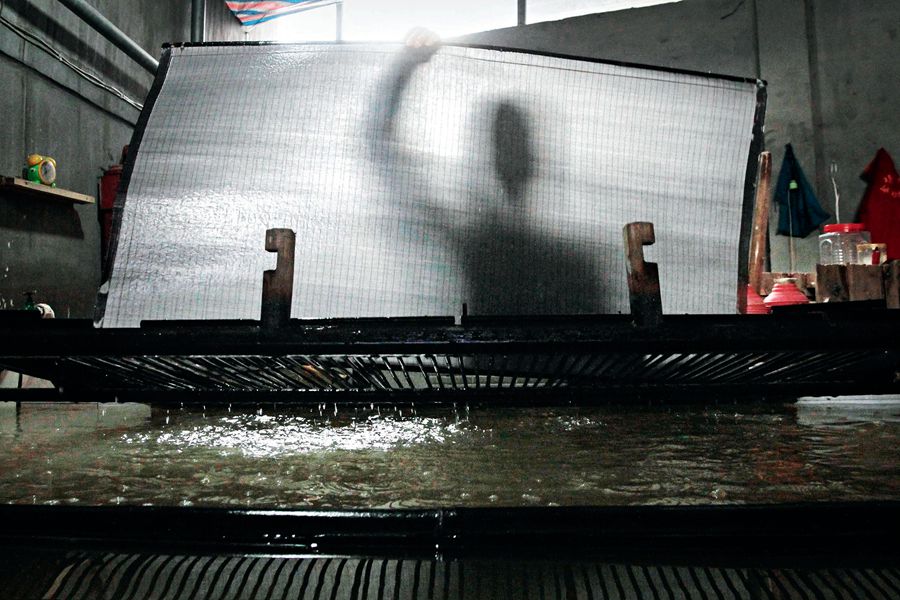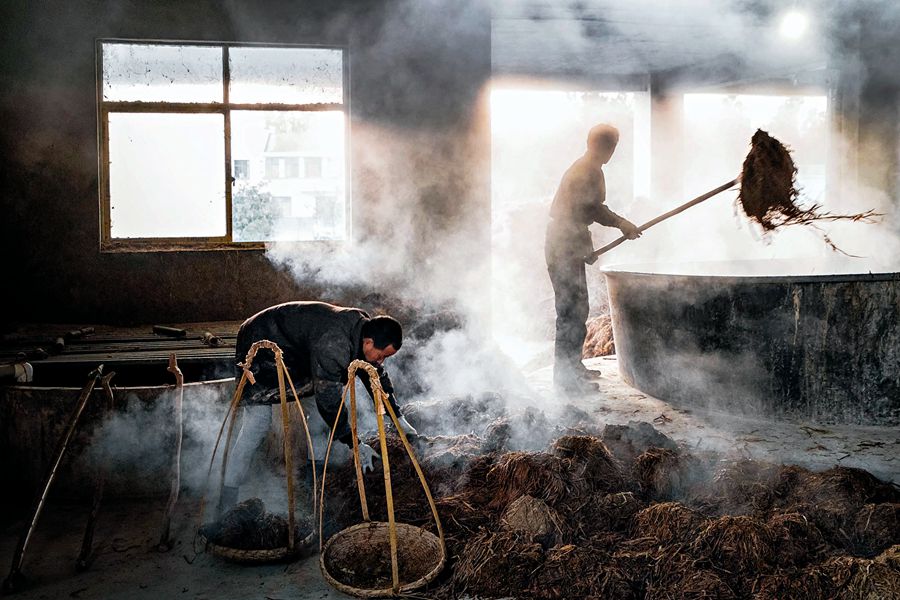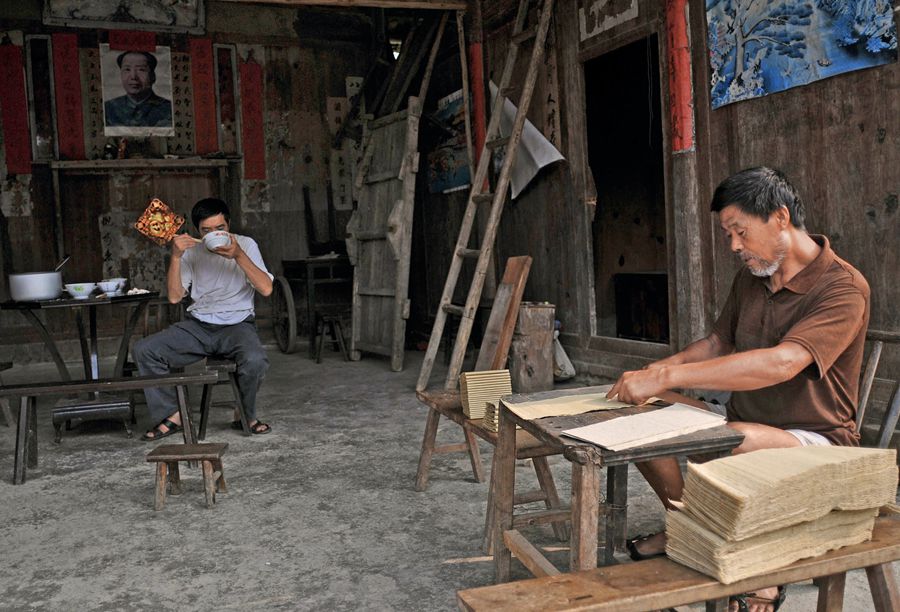PAPER plays a key role in the inheritance of culture and social progress. Paper making is one of China’s greatest inventions which dates back to 2,000 years ago. Compared with other writing materials, paper is cheap and easily accessible, which is why it was favored by Chinese and subsequently spread worldwide.
Traditional Chinese paper making is done by hand. Bamboo, fiber, and bark were used as raw materials. They were soaked, fermented, steamed or boiled, bleached, beaten, and dried before finally being transformed into recognizable paper.

Unique bamboo curtain is used in the screening process of bamboo paper making in Jiajiang, Sichuan Province.
In modern times, machine-made paper produced from wood was invented in the West, which added more varieties of paper and highly improved the efficiency of paper making. Gradually, handmade paper was replaced, and no longer exists in daily writing or printing. But in some parts of China, the traditional method of paper making is still in use for purposes of calligraphy and art.
Xuan Paper of Anhui Province
Xuan paper is used in traditional Chinese calligraphy and painting. It was originally produced in Xuancheng City of Anhui Province, hence the name Xuan paper. Renowned for its softness and fine texture, it is perfectly suited for conveying the artistic expression of Chinese writing and painting.
According to folklore, after the death of Cai Lun (61 or 63-121), who made big improvements to the paper making craft, his apprentice Kong Dan wanted to produce a kind of snow white paper to paint an image of Cai as a symbol of remembrance. One day, he came across an old blue sandalewood tree lying across a stream in a canyon in southern Anhui. After years of washing and erosion by running water, the bark decayed and revealed long white fibers. Overjoyed, Kong experimented with the bark until successfully producing what was the precursor of the Xuan Paper.

Craftspeople are manufacturing Xuan paper at a local workshop in Jingxian County of Xuancheng City, Anhui Province, on January 10, 2018.
In the Tang Dynasty (618-907), Xuan Paper was already in use for writing and painting, and selected for tribute to the royal family. The last emperor of the Southern Tang Dynasty Li Yu (937- 978) oversaw the manufacture of Chengxintang paper, a high-end Xuan Paper. It is ultra-soft and thin, as well as having great tensile strength, as a result of which it is hailed as the best paper in China’s paper-making history.
Xuan paper has a range of distinctive properties. It is durable and endures the passage of time well without fading color, while also allowing ink to blur easily when used. This makes it ideal for Chinese brush work, permitting the shades of color and texture to be easily visible with distinct gradations. Paintings on Xuan paper with a history of more than 1,000 years preserved in the Palace Museum or other local museums in China are testimony to the paper’s outstanding durable qualities.
The main material for making Xuan Paper is blue sandalwood bark growing in the mountains of south Anhui. Straw is also added. The production process is long, including 18 steps, some of which are kept secret from outsiders. The bark is from tender branches about two or three years old as their fiber is the most suitable both in size and quality.
Due to different production methods, Xuan paper can be classified into raw Xuan, ripe Xuan, and semi-ripe Xuan.

Guizhou Pi paper is made with indigenous methods.
Raw Xuan excels in its ability to absorb water, therefore causing rich ink gradations. It is favored by landscape painters. Ripe Xuan, however, has potassium alum added to the surface during production, which results in a stiffer texture and a reduced ability to absorb water. This feature makes it more suitable for Gongbi painting (a realist technique) rather than Xieyi painting (a spontaneous style). Semi-ripe Xuan has intermediate absorbability between raw Xuan and ripe Xuan.
Apart from acting as painting material, Xuan paper was also used to record diplomatic notes, to preserve important files, and historical records. Most ancient books preserved till today in China used Xuan paper, proof that it could stand the test of time.
At the beginning of the last century, due to wars, Xuan paper production was endangered. After the People’s Republic of China was founded in 1949, production was resumed. In the past four decades, Xuan paper has continued to develop. Thanks to the efforts made in the protection and development of making Xuan paper, the process was passed down from generation to generation. In 2006, the traditional craft of making Xuan paper was listed as an intangible cultural heritage in China, and in 2009, it was selected as a UNESCO Intangible Cultural Heritage of Humanity.
Pi Paper of Guizhou Province
Pi paper originated in Shiqiao Village, Danzhai County in Guizhou Province. Shiqiao is cohabited by Han and Miao ethnic groups. It is situated in a valley where rivers and mountains abound. This geographical location gives it a natural advantage to make paper as water and wood, the two main ingredients, are plentiful. The local paper making craft dates back over 1,000 years, and can still be seen in Shiqiao today.
The material for Shiqiao white Pi paper is the bark of a kind of local tree, with no other materials added. Every March to May, tree branches are cut down, and heated at 30-40OC, after which the bark is peeled off and processed. The Shiqiao white Pi paper, famous for its whiteness, tensile resistance, smooth surface, and being highly absorbent, is the optimum choice for the restoration of ancient books, painting, and writing.
In the 1990s, the ancient manual method of paper making was overshadowed and marginalized by the productive modern paper industry. As a result, most villagers gave it up, but crafter Wang Xingwu was an exception. Unwilling to abandon what his ancestors had passed down to him, he tried to renovate the ancient handicraft. From 2000 to 2008, he added new elements to the old techniques and finally succeeded in making a series of paper adaptable to modern needs and tastes.
Traditional Shiqiao paper came in only white color. In 2000, Wang managed to produce colored paper by adding with plant juices and made various tourist handicrafts with them, which were widely favored by visitors from home and abroad. As the pigments used are all natural, they contain no chemicals and are environmentally friendly. They sell well especially in Hong Kong.
In 2006, Wang channeled his energy into the paper used in repairing ancient books. He consulted numerous experts and through trial and error, he succeeded by producing Yingchunmiao Paper, which was later selected to the restoration of cultural relics at the National Library and National Museum. In the same year, Guizhou Pi paper, represented by Shiqiao white paper, was included in China’s intangible cultural heritage list.
Bamboo Paper of Sichuan Province
The first paper invented in China was made from bark, hemp, and other materials. After more than 100 years of development, however, bamboo, as a new raw material for paper making, became popular in southern China in the third century.
In the beginning, bamboo paper was crisp and fragile. With the improvement of the craft, it finally gained acceptance and, gradually exceeded the paper made of bark and hemp in output. The bamboo paper making in Jiajiang County of Leshan City, Sichuan Province, began in the Tang Dynasty, when it was used by the royal family and extensively in the imperial examination.
During the War of Resistance against Japanese Aggression(1931-1945), Sichuan became the political, economic, and cultural center of the area at that time. The need for paper was on the rise. Among the 29 paper-making regions in Sichuan then, the bamboo paper produced in Jiajiang was the greatest in quantity and the best in quality. In the 1940s, the famous painter Zhang Daqian visited Jiajiang twice, and joined by local craftsmen, he revamped the Jiajiang bamboo paper into a sublime surface for painting and writing, which was later named after him.
Till now, bamboo paper has maintained a completely traditional production process. There are 15 procedures with 72 steps from material selection to paper making. Different from many other places where bamboo paper is made, Jiajiang artisans still adhere to old processing methods. For example, the “screening” process – submerging a mesh in the solution, then pulling, shaking, and draining it to form a uniform coating on the screen – is operated by one person instead of two in other places. These unique skills have made bamboo paper making techniques in Jiajiang full of local culture, and enriched Chinese paper making techniques on the whole.
Besides, a whole set of cultural activities related to bamboo paper making was born in Jiajiang. The most famous one is the ballads sung during work, with which the craftsmen express their feelings.
In 2006, Jiajiang bamboo paper making handicraft was listed as an intangible cultural heritage in China.
(Compiled by China Today)


